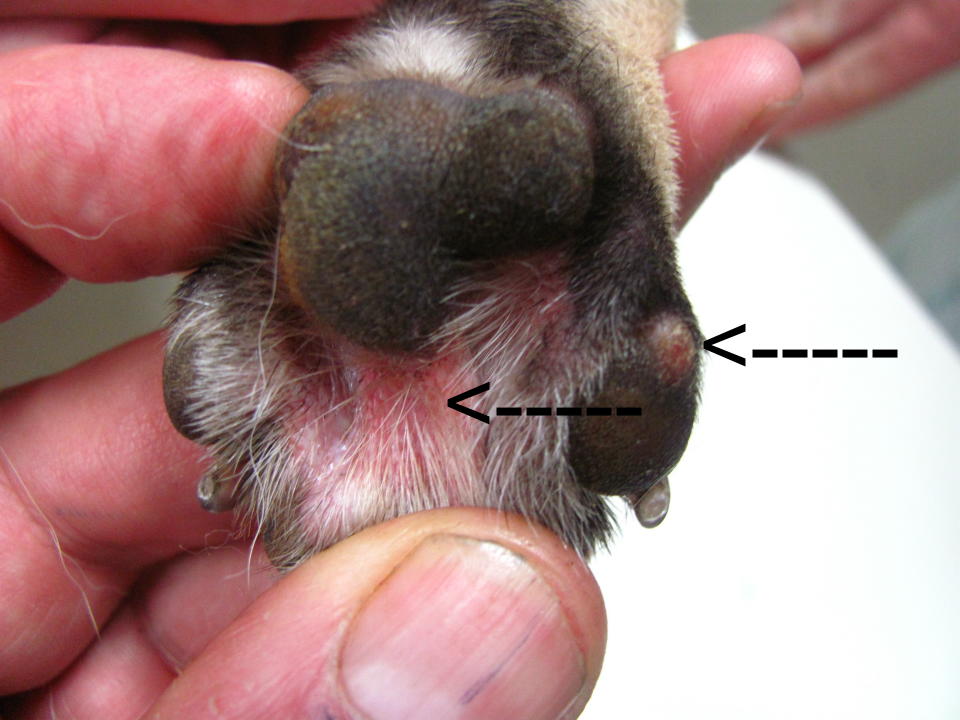Dog Paw Redness: Causes, Treatments, and Prevention
Noticing redness between your dog's paws can be alarming. Is it something serious? Should you rush to the vet? While it's always best to consult a professional, understanding the potential causes can help you determine the urgency and provide some peace of mind. This comprehensive guide will explore the common reasons behind red paws in dogs, offering insights into diagnosis, treatment, and prevention.
Redness on a dog's paws, specifically between the pads, isn't a condition in itself but rather a symptom of an underlying issue. Imagine it like a red flag waving, signaling something might be amiss. This redness can range from a slight pink tinge to a fiery crimson, often accompanied by other symptoms like itching, licking, swelling, or even hair loss. The severity and accompanying symptoms provide crucial clues to the underlying cause.
Several factors can contribute to inflamed paw pads. Allergies, perhaps the most frequent culprit, can manifest as paw pad redness due to contact with allergens like grass, pollen, or certain cleaning products. Infections, whether bacterial, fungal, or parasitic, can also cause inflammation and discoloration. Environmental irritants, such as road salt, hot pavement, or rough terrain, can also lead to redness and discomfort.
Determining the exact cause of your dog's red paws often requires a bit of detective work. Start by carefully examining the affected area. Is the redness localized to the paws, or does it extend to other parts of the body? Are there any open sores, blisters, or discharge? Note any accompanying symptoms like excessive licking, chewing, or limping. This information will be helpful when consulting your veterinarian.
While online resources can provide valuable information, they shouldn't replace professional veterinary advice. Your vet can perform a thorough examination, including skin scrapings or cultures if necessary, to pinpoint the cause of the redness. They can then recommend the most appropriate treatment, which might range from topical creams and oral medications to dietary changes or environmental modifications.
Understanding the history of similar issues in your dog's lineage can be helpful. Some breeds are predisposed to certain skin conditions that can manifest as paw redness. For example, breeds with skin folds, like Bulldogs, are more prone to yeast infections that can affect the paws. Knowing your dog's breed-specific predispositions can aid in early diagnosis and prevention.
Interdigital dermatitis, or inflammation between the toes, is a common manifestation of paw redness. This condition can stem from various causes, including allergies, infections, and parasites. Another related issue is pododermatitis, which is a broader term encompassing any inflammation of the paw.
One benefit of addressing paw redness early is preventing secondary infections. Constant licking and chewing of irritated paws can introduce bacteria, leading to more serious complications. Another benefit is improving your dog's overall comfort and quality of life. Finally, proactive management of paw issues can save you money on costly veterinary treatments down the line.
Start by consulting your vet for a proper diagnosis. Once the underlying cause is identified, follow the prescribed treatment diligently. For allergies, this might involve avoiding known allergens or administering antihistamines. For infections, antibiotics or antifungals may be necessary. In all cases, keeping your dog's paws clean and dry is crucial.
Consider these best practices: 1) Regularly inspect your dog's paws. 2) Wipe their paws after walks, especially in areas treated with chemicals. 3) Keep your home clean and free of potential allergens. 4) Provide a balanced diet and consider supplements for skin health. 5) Consult your vet at the first sign of redness or irritation.
If your dog's paws appear irritated after a walk, try rinsing them with lukewarm water. If the redness persists, a vet visit is recommended. While home remedies like soaking paws in Epsom salts can sometimes offer relief, it's essential to get a proper diagnosis before attempting any at-home treatments.
Advantages and Disadvantages of Certain Treatments
Frequently Asked Questions:
1. Why are my dog's paws red between the pads? Many factors can cause this, including allergies, infections, and irritants.
2. Is it serious if my dog's paws are red? It depends on the underlying cause. Consult a vet for diagnosis and treatment.
3. What can I do at home for my dog's red paws? Keep the paws clean and dry and consult a vet for appropriate treatment.
4. How can I prevent my dog's paws from getting red? Avoid known allergens, wipe paws after walks, and maintain good hygiene.
5. Are certain breeds more prone to red paws? Yes, some breeds are more susceptible to skin conditions that can cause paw redness.
6. Can food allergies cause red paws? Yes, food allergies can manifest as paw redness and itching.
7. What are the signs of a paw infection? Redness, swelling, discharge, licking, and chewing are potential signs.
8. When should I take my dog to the vet for red paws? If the redness persists, worsens, or is accompanied by other symptoms.
Taking care of your dog's paws is a crucial part of responsible pet ownership. Paw redness can indicate a range of issues, from minor irritations to more serious infections or allergies. By understanding the common causes, practicing preventive measures, and seeking timely veterinary care, you can ensure your furry friend's paws stay healthy and comfortable. Don't hesitate to contact your veterinarian if you notice any redness or changes in your dog's paws. Early intervention can prevent complications and keep your canine companion happy and active. Be proactive, and your dog will thank you for it!
Perfecting your couple profile picture captions and beyond
Finding peace the allure of a ranch house with a gable front porch
The world of 16 year olds navigating the threshold of adulthood













